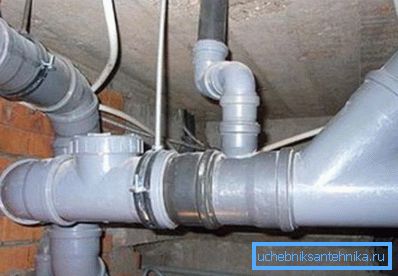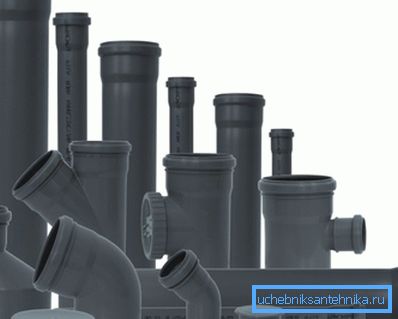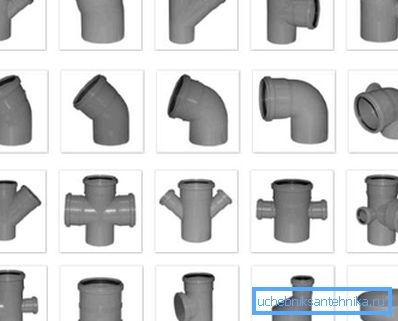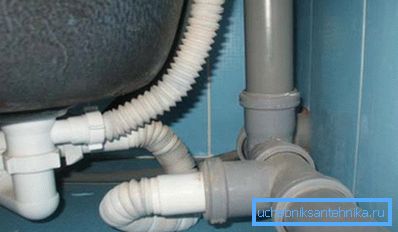Pipes for domestic sewage: the choice and application
Nowadays, PVC pipes for domestic sewage and their cast iron counterparts are commonly used. But what is better and what is worse, what are the reasons for choosing polymer products and why metal products gradually lose their former popularity? We will tell about this and many other things in this article.

Features of choosing the best option

With modern construction of housing and public facilities, domestic sewage pipes made of polyvinyl chloride or cast iron are used. Consider the features inherent in each of these categories.
Cast iron products have been used for more than 100 years and thanks to such a long-term approbation we know everything that is necessary about their advantages and disadvantages.
Unfortunately, there are an order of magnitude more deficiencies and among them it is necessary to note the low corrosion resistance and, as a result, the formation of hidden leaks after a short period of operation, the complexity of mounting with their own hands, etc.
PVC PVC products are gradually replacing cast iron.
And this is not surprising, since plastic has many advantages, including:
- long operational resource without change of technical characteristics (not less than 50 years);
- absolute resistance to corrosive processes;
- low weight;
- low price in comparison with metal counterparts;
- ease of installation and dismantling, and, consequently, ease of repair work;
- there is no need for regular cleaning, since the inner walls are ideally smooth, and therefore no contaminants are deposited on them;
- a wide range of sizes and configurations and, as a result, the possibility of building systems of any complexity.
Plastic pipes and fittings

PVC sewage internal pipes are manufactured using such polymeric compounds as polyvinyl chloride (PVC), polypropylene (PP) or polyethylene (PE). The most widespread modifications made of polypropylene and polyvinyl chloride. Products made of polyethylene, due to lower strength, are not widely used today.
Earlier, we considered the advantages of plastic pipes, but one wonders if there are disadvantages along with the advantages? It turns out that there is one major drawback, namely, insufficient sound insulation. As a result, the flow of fluid through the pipes is well heard throughout the room.
However, this disadvantage is easy to eliminate. It is enough to put thermal insulation of polyethylene foam on the pipes during installation or at the end of it, and almost no water can be heard. Well, as a bonus, sewage with external location will not be covered with condensate.
More sophisticated methods of improving sound insulation are the construction of special boxes around the pipes. Insulating material such as mineral wool is placed in the box, and no water can be heard at all.
Features of the installation work with the use of polymer pipes

Assembly instructions sewage systems of polymer components is unlikely to cause any difficulties, and therefore with such work you can handle on their own.
The pipes on one side are equipped with a socket with an o-ring inserted into the inner chute. On the other hand, the end of the pipe is seamed and just adapted for insertion into the socket.
In addition to pipes, additional accessories will be required for mounting the system, such as various adapters, tees and elbows. The listed accessories, as well as pipes, are equipped with connecting elements.
The connection of all elements into a single system is as follows:
- The arrangement of all elements with the indication of the length of the pipes is projected, the internal dimensions of the PVC sewer pipes are also taken into account.
- Pipes are cut with a hacksaw for metal in accordance with the required dimensions.
- The cut end is ground with sandpaper to facilitate entry into the socket.
Important: Cutting of pipes is made from the end opposite to a bell.
- We correct the sealing ring in the socket and make sure that it is level and not twisted.
- We lash the seamed end of the pipe and with medium force gradually screw it into the socket of the element to be attached.
After the entire system has been assembled, it is necessary to wait for some time in order for the soapy parts of the joints to completely dry out, after which you can check the system for tightness.
Features of the installation work with the use of cast iron pipes

Pig-iron sewer pipes and fittings for internal sewage are mounted into a single system 10 times more complicated. The complexity and complexity of the process is due to the large weight of the products and the features of the joining of elements (see also the article Depth of the sewage system - the main aspects of this issue).
Important: If the assembly of polymer systems can be assembled where it is convenient for you, then cast iron systems are mounted directly where they will later be used.
The docking of cast iron pipes is performed using a socket or socket joint. In this and in another case, the installer will need sufficient experience in such work and appropriate physical training.

Coupling is performed by qualified professionals and because of the complexity of the execution today almost never used.
Bell fitting is the most common. In this case, the cast-iron pipe at one end is flat, and on the other hand has a rounded socket, inside which is installed the sealing ring. By pushing the pipes into the socket you can assemble a system of the required size and the required configuration.

The section of the socket connection is additionally sealed with hemp or bitumen and cement coating in order to avoid subsequent leaks.
Conclusion
So, we considered the main types of pipes used for the assembly of internal sewer systems. Now you know which products are cheap and at the same time high-quality and easy to use, and which are expensive and difficult to use (read also the article How a rainwater drainage system is designed).
As a result, you can draw the appropriate conclusions and choose the best pipes and related accessories. You will find more useful information by watching the video in this article.